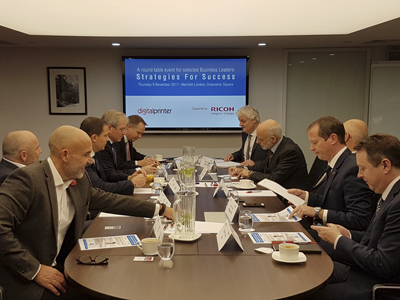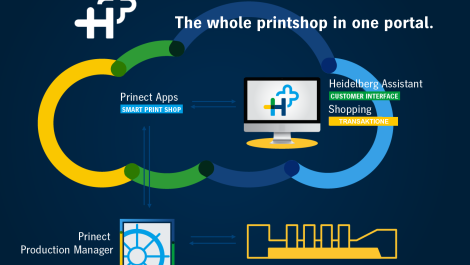Getting down to business: the roundtable begins
Before last month’s Digital Printer Awards, Ricoh hosted a roundtable discussion at which the leadership challenges posed by digital ways of working were explored. Michael Walker chaired.
A survey conducted by Ricoh towards the end of 2016 revealed that European employees in a range of industries are broadly positive about the productivity and prospects that new “digital” technologies can offer them in their working lives, but are looking to their employers to help and guide them through the changes.
To focus on how employers should respond, Ricoh convened a roundtable discussion of printers, suppliers and industry representatives to address key themes that emerged from the research: automation, digital disruption, and employee engagement and loyalty.
There was broad consensus that automation was essential. Simon Tabelin of It Has To Be Brilliant perhaps put it most succinctly: ‘We automate to compete’. Charles Jarrold, CEO of the BPIF, suggested that tools like customer relationship management (CRM) systems were ‘highly evolved, but not adopted’, a view that was echoed by John Charnock, consultant and managing director of Belfast printer Nicholson Bass, who highlighted that handling digital print via a traditional (litho) cost model didn’t reflect – let alone minimise – the transactional costs adequately.
Automating the estimating function was a popular idea, with Mr Charnock suggesting that 90% of simple quotes could be automated, leaving 10% requiring “estimator intelligence” but Lee Deeks of Passion Print warned that the tough part is getting people to change. ‘We’ve had training on Time Harvest but only two people use it,’ he said. Against that was the view from Mr Tabelin that tools like this ‘take away some of the responsibility’; he also reported that there wasn’t an age bias in acceptance – or otherwise – of new technology in his company.
Morgana’s UK sales manager Paul Williams said that it had taken 18 months to fully implement a new CRM which was now ‘starting to give excellent feedback’ but that ‘the data has to be right’.
Data was a sore point for Mr Tabelin who said that ‘every job is exceptional’ and that even for a set of hierarchical business cards, 28 templates are required. Mr Jarrold agreed that while “MIS 1.0” that handles internal job tracking and quoting was something that every printer has, the requirements for the next generation, with customer-facing integration to streamline purchasing, are extremely complicated: ‘It’s easier to buy a press than a [management information] system; it involves every department.’
Nick Murray of Wellington Print queried whether the cost and effort of setting up such a system could be justified for small companies, while the question of whether automated based pricing facilitated or obstructed entrepreneurial activity revealed differences of opinion, with Mr Tabelin saying it made things “difficult”, and Mr Murray pointing out that incomplete quoting systems could leave customers with “pages of extras”.
‘Entrepreneurial businesses see the opportunity before anyone else does; it’s important to get on board early’ maintained Mr Charnock, while Tony Kenton of It Has To Be Brilliant suggested that automation should be used to identify the customer’s broader objective, as this ‘gives greater value to the client; they can’t do without us – they rely on our brains’.
Referring to predictions of the number of jobs potentially being lost to automation in coming years, Mr Kenton also warned, ‘If your people are being replaced by systems, you’re in the wrong business. “Green button” technology means taking the margins out.’
Mr Charnock had the last word on automation, pointing out that the print industry had been one of the first to employ robots: ‘We’ve always been taking on the latest technology,’ he concluded.
Volume or value?
The theme of automation taking jobs fed into the disruption part of the discussion, with Mr Jarrold quoting trade union Unite’s prediction that 35% of its members’ jobs would disappear in the next 20 years, saying ‘It’s inevitable that we’ll see lots of skilled professional jobs go in the next 10 to 15 years’. He suggested that BPIF apprenticeships might be a route to gaining skills that will still be needed.
Mr Deeks thought that not everything could be automated, such as in finishing where ‘you can’t tell a robot to trim one mil for a roll-fold’; Mr Charnock contrasted finishing as one of the least standardised processes in print with colour, which has ‘hundreds’, though Mr Williams suggested that 90% of finishing could be done to an acceptable standard via push-button equipment, leaving 10% as an opportunity to add value. Mr Deeks agreed, saying, ‘don’t do flyers; we want jobs with shape, things that you can’t automate’.
Commenting that Nicholson Bass’s parent Quinns was using top of the range equipment and highly batched production to increase volumes, Mr Charnock stated: ‘You can offer commodity or value. You can’t do both.’
The implications of mobile communications technologies were largely felt to centre around social media. Lee Deeks said ‘You have to be careful, especially outside of work but it can help to secure business’. John Charnock suggested that near-field communications (NFC) and RFID tags could replace the conventional clocking-in process but Nick Murray pointed out that ‘you have to give a bit’ too. Mr Deeks takes a relaxed approach to use of mobile phones and social media in the workplace: ‘As long as the job’s done right and on time, there are no issues. Most [people] are responsible.’
Looking at how to put mobile technologies directly to work for clients, Simon Tabelin described augmented reality (AR) and virtual reality (VR) as channels that complement or even drive print sales, by putting NFC chips into vinyl so that even vehicle graphics can trigger trackable interactions. The AR/VR opportunity was also endorsed by John Charnock, who pointed out that ‘you have to have a real world to put a virtual world on top of’.
Tony Kenton was more cautious about how quickly this can be done, suggesting that it could take four or five years to implement but that it was important to ‘run to where the puck’s going to be’. He also took issue with the phrase “digital disruption”, proposing that it was actually digital collaboration, where ‘all digital channels are part of the mix’. However, taking advantage of the possibilities will require upskilling plus the ability to source and combine a wide range of “boutique” skills to add value.
Engagement and loyalty
Where there is an age divide connected to technology, it’s around the use of mobile communications which may be an essential part of life for today’s 20-to-30 year olds but can be viewed by their elders as snooping devices. Paul Williams explained that there can be positive effects, for example fleet tracking technology meaning that field service engineers now check if there are additional calls that can be fitted in on the way home.
Perhaps more critical to employee loyalty than the amount of time spent on Facebook for whatever reason is the number of jobs that younger staff members can expect to have during their working lives. ‘Some have had 20 jobs, even in the last generation,’ said Tony Kenton, adding, ‘People are more transient and won’t have the opportunity to train for three or four years; no one will invest the time.’
John Charnock agreed that younger staff were more transient but added that ‘training gets loyalty’, while Tony Kenton was in favour of mentoring, even if it meant helping with career development outside the company. Mr Charnock explained that he looks at ‘attitude, not length of service’, while Nick Murray added that staff wanted to see progression in the equipment they were given to use, citing the example of a digital cutting table which at first met with resistance but ‘now they can’t be without it’.
The theme of give-and-take for mobile or remote workers arose again, with Mr Murray opining ‘It’s trust; people can start late or leave early if it’s followed by a long day. You hope your trust will give loyalty back’. Mr Charnock added, ‘It’s about building culture, letting people think for themselves.’





